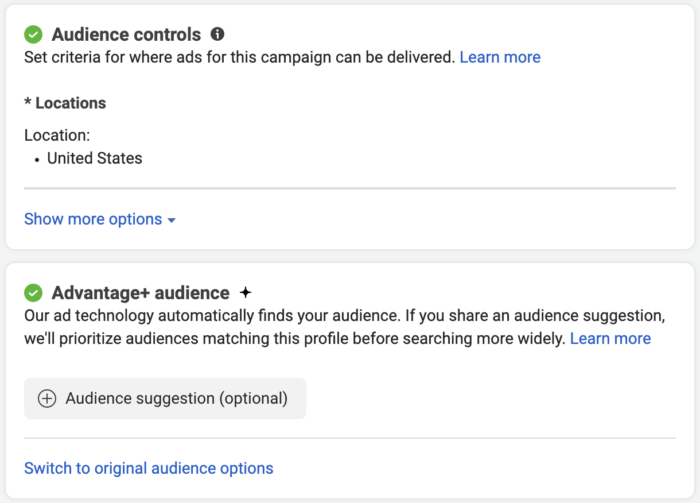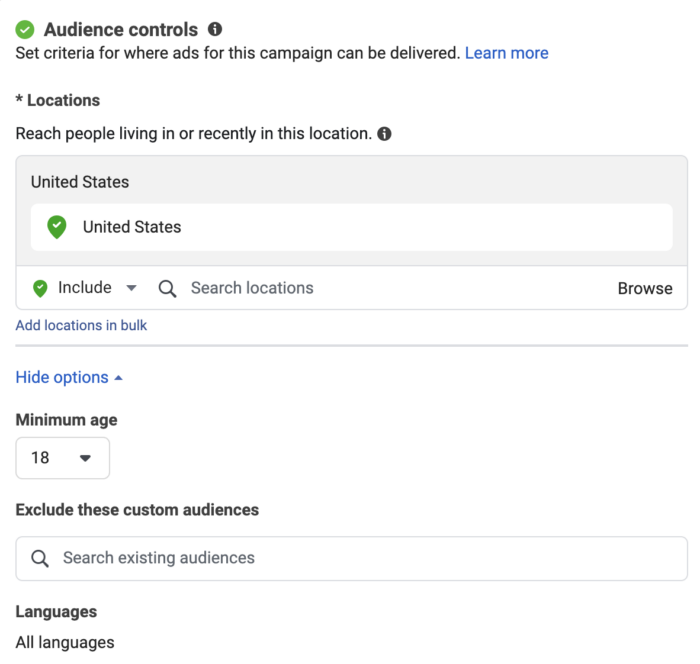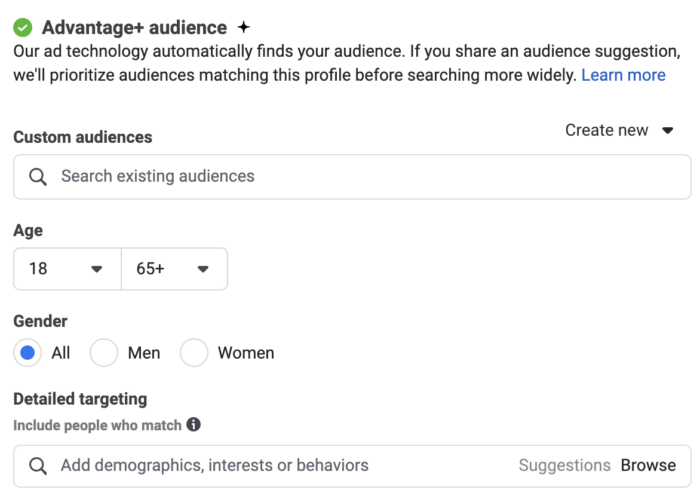Meta first introduced Advantage+ Audience when it announced AI-powered ad tools in May of 2023. It will sound eerily similar to the other Advantage audience expansion products. There are some important differences.
Let’s take a detailed look at what Advantage+ Audience is, how it works, how to set it up, and my expectations for the future of Meta ads targeting.
What Is Advantage+ Audience?
You have access to Advantage+ Audience if you see this in the ad set…

Advantage+ Audience is a targeting setting that allows Meta to use AI to determine the audience that will see your ads. To determine this, Meta’s systems are constantly learning from your pixel data, conversions history, and people who have engaged with your previous ads and content.
You can choose to either trust Meta to find your target audience for you without any input or you can provide some inputs as audience suggestions. Your suggestions can include:
- Custom Audiences
- Lookalike Audiences
- Age Range
- Gender
- Detailed Targeting
Meta will prioritize reaching people who match these suggestions before expanding to people more broadly.
Meta provides some convincing stats regarding the effectiveness of Advantage+ Audience.

While I don’t care a whole lot about a 28% lower Cost Per Click or Landing Page View (that doesn’t mean a lower Cost Per Action), the 13% lower Cost Per Product Catalog Sale and 7% lower Cost Per Website Conversion are worth notice and potentially significant.
Audience Controls
Audience Controls are tight constraints, rather than suggestions, that Meta must respect when choosing your Advantage+ Audience. This includes:
- Locations
- Minimum Age
- Excluded Custom Audiences
- Languages
This works much like the Audience Controls for Advantage+ Shopping. You may only ship to customers in certain countries or states. Your product may not be available to people under a certain age. Or your product may not be relevant to those who already bought it.
These controls are necessary in those cases.
When You Can’t or Shouldn’t Use It
Advantage+ Audience is not available for the following situations:
- When promoting a Special Ad Category
- Advantage+ Shopping Campaigns
- Advantage+ App Campaigns
- Retargeting campaigns using Advantage+ Catalog
Meta already utilizes AI to generate your audiences for Advantage+ Shopping and Advantage+ App Campaigns.
Meta also recommends that you don’t use Advantage+ Audience generally when remarketing.
Set Up Audience Controls
When you click to Show More Options within Audience Controls, you’ll see minimum age, excluded custom audiences, and languages.

These are the tight constraints that Meta must follow when finding your audience. So, even when finding people beyond your suggestions, these rules will apply.
Here are a few things to consider…
1. Location. First, you will need to select countries or states if you can only ship to certain locations. But you should also consider including only certain countries here, too, depending on your optimization. Unless you optimize for a purchase, you can expect your ads to be delivered primarily to the cheapest countries. By default, Meta will include your home country here.
2. Minimum Age. There’s really no reason to include anything here unless there’s a legal reason to set a minimum age. Ignore the age of your “typical” customer. Meta will sort this out.
3. Excluded Custom Audience. Use this only when necessary. For example, you’re promoting a product that can only be purchased once.
4. Languages. Meta recommends leaving this blank unless you want to show your ads to people in a language that isn’t common to a location.
Set Up Advantage+ Audience

First, a couple of things to keep in mind here…
1. You can provide an audience suggestion, but it’s optional. At some point, you should experiment with both approaches: Providing a suggestion and not.
2. You can switch back to original audience options. If you’re not ready for this, know that it’s not forced on you (yet, at least). You can still go back to the old ways of targeting.
But you can provide custom audiences, lookalike audiences, an age range, gender, and detailed targeting as suggestions.

Just keep in mind that these are not tight constraints. Meta will prioritize these suggestions initially, but your ads can still reach people who wouldn’t qualify. If you have a tight constraint on age, you need to provide it in Audience Controls.
How Is This Different?
If you’re confused by how this is different than simply using Advantage Custom Audience, Advantage Lookalike, and Advantage Detailed Targeting, I totally understand. This stuff is eerily similar.
In both cases, Meta prioritizes the initial audience — at least, at first. In both cases, Meta can expand the audience to reach people beyond that group.
Here are the main differences, the way I understand it…
1. Age and Gender. When you use Advantage Detailed Targeting, Advantage Lookalike, or Advantage Custom Audience, Meta uses age and gender as tight constraints. The expanded audience will respect those settings. That isn’t necessarily the case with Advantage+ Audience.
While you can set a minimum age when setting up Advantage+ Audience using Audience Controls, the age range that you provide is a mere suggestion. The same goes for gender. You may think only women care about your product, but Meta can reach men if it’s determined it will help you get better results.
This may sound crazy, but it’s a matter of trusting the AI. Meta is learning from your data and results. You shouldn’t expect your ads to suddenly get shown to men if only women purchase.
2. Extent of Expansion. Meta actually calls this out specifically when talking about the benefits of Advantage+ Audience.

Advantage+ Audience provides the “broadest possible audience to search within.” Meta even says that this limitation prevents those other options from being more effective. That inability to go as broad limits the AI.
This also goes back to one of my original issues with Advantage Detailed Targeting, Advantage Lookalike, and Advantage Custom Audience. We’ve never known how much Meta actually expands our audience when these are turned on. There’s not a way to see results broken down by people you targeted versus those who were part of the expanded audience.
The result was that most advertisers assumed that Meta was significantly expanding our audiences. But that may not have been the case.
Versus Going Broad
Going broad with targeting (removing all interests, behaviors, custom audiences, and other targeting) has increased in popularity among advertisers. How is this different?
You could set up an ad set using broad targeting without any inputs. You could also use Advantage+ Audience without any targeting suggestions. My understanding is that your ads will be delivered differently in each case.
Or at least slightly differently. We’ve heard about the power of broad targeting, but Advantage+ Audience is another level of AI targeting power. It’s similar to how the targeting power for purchases is greater for Advantage+ Shopping Campaigns than simply going broad when optimizing for purchases.
At least, this is how Meta advertises it. Feel free to test!
When To Use It
Like any strategy, you should experiment and find when it works best for you. If you had asked me a year ago what I thought about broad targeting or any of the audience expansion products, I’d give you a much different answer than I would now. Don’t assume that this is a bad idea.
In my opinion, this is best when optimizing for any type of conversion, especially a purchase (when not running Advantage+ Shopping Campaigns). I’d be wary of using it for top-of-the-funnel campaigns that optimize for link clicks, landing page views, video views, or any type of engagement, but we should still experiment.
The reason I’d be hesitant to use this for surface level engagement is that the algorithm will just work harder to get you those cheap actions. And those cheap actions are often not high-quality actions. And the algorithm won’t care.
That brings up a whole different philosophical discussion and a potential solution if Meta ever wants one. They could provide optimization options for high-quality traffic and engagement to prevent this potential issue.
The Future of Targeting
This is the direction Meta ads targeting has been going ever since the launch of Detailed Targeting Expansion (before it became Advantage Detailed Targeting). More automation. Less control. More AI-powered learning. And ultimately, less transparency in reporting and more trust in the algorithm.
This is just a hunch, but I assume that Advantage+ Audience will eventually completely replace Advantage Detailed Targeting, Advantage Lookalike, and Advantage Custom Audience. There’s simply no value in having them anymore. They are too similar, and keeping them will only confuse advertisers.
We’re getting much closer to a time when we won’t provide any targeting at all. While that may sound scary, the truth is that Meta already has our targeting in the form of historical data. We don’t necessarily need to provide anything because the algorithm already knows who has converted on our website and is engaging with our ads and content.
Watch Video
I recorded a video about this, too…
Your Turn
Have you experimented with Advantage+ Audience? What do you think?
Let me know in the comments below!






